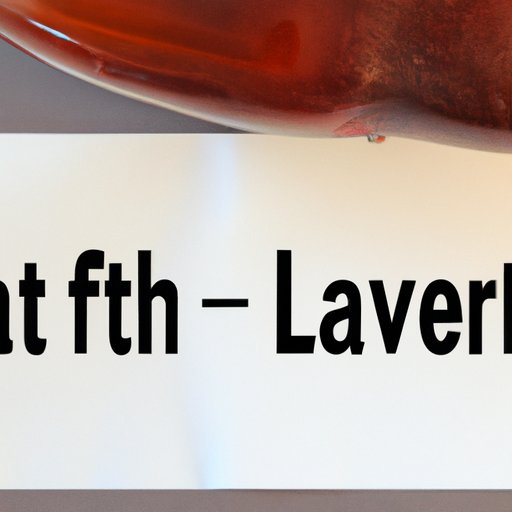
Introduction
Fatty liver disease is a leading cause of chronic liver disease in the United States with approximately 80 to 100 million Americans being affected by this condition. Being diagnosed with fatty liver disease can be concerning, but there are ways to address it. It is essential to understand the causes and consequences of fatty liver disease in order to take the necessary steps to reverse it.
Is Reversing Fatty Liver Disease Possible? A Comprehensive Guide
The good news is that fatty liver disease can be reversed. However, the extent to which liver health can be restored is dependent on several factors including the duration and severity of the condition, as well as the effectiveness of treatment.
Studies have shown that reducing the intake of saturated and trans fats in the diet and losing weight can significantly improve liver health. Modifying lifestyle habits such as diet and exercise can be effective when done consistently and over time.
The Top 5 Ways to Reverse Fatty Liver Disease
There are several ways to reverse fatty liver disease. Below are the top 5 most effective ways to do so:
A. Exercise Regularly
Engaging in regular physical activity can help reduce liver fat by burning excess calories and reducing inflammation. Regular exercise has been shown to improve insulin sensitivity, reduce oxidative stress, and decrease inflammation in the liver, which can contribute to improved liver function.
B. Follow a Healthy Diet
Eating a well-balanced diet that is low in saturated and trans fats is crucial for reversing fatty liver disease. A diet rich in fruits, vegetables, whole grains, and lean proteins such as fish and chicken is recommended. Additionally, limiting the consumption of sugary and processed foods can help reduce liver fat.
C. Avoid Consuming Alcohol
Alcohol consumption can cause significant damage to the liver, especially in individuals with fatty liver disease. It is essential to limit or avoid alcohol altogether in order to promote liver health.
D. Manage Underlying Conditions Like Obesity and Diabetes
Obesity and diabetes are common risk factors for fatty liver disease. Managing these underlying conditions, through a combination of lifestyle changes and medication if necessary, is crucial for reversing fatty liver disease.
E. Take Prescribed Medications If Necessary
In some cases, medications such as insulin-sensitizing agents, cholesterol-lowering drugs, and antioxidants may be recommended by a physician to help reverse fatty liver disease. These medications should only be taken under the guidance of a healthcare provider.
A Step-by-Step Plan to Reverse Fatty Liver Disease Naturally
Developing a comprehensive plan for reversing fatty liver disease can be overwhelming, but it is essential for success. Below is a step-by-step guide to developing a plan:
A. Establish Goals and Objectives
Clearly outlining goals and objectives is an essential first step in developing a plan to reverse fatty liver disease. Setting achievable and realistic goals can help maintain motivation and track progress.
B. Make Dietary Changes
Making dietary changes is critical for reversing fatty liver disease. Reducing the intake of saturated and trans fats and increasing the consumption of fruits, vegetables, whole grains, and lean proteins should be the main focus of dietary changes.
C. Implement an Exercise Program
Developing an exercise program can help reverse fatty liver disease by increasing physical activity levels. Engaging in aerobic and strength-training exercises at least four times a week for 30 minutes has been shown to be effective.
D. Incorporate Healthy Habits Into Daily Routine
Incorporating healthy habits into one’s daily routine can be an effective way to support liver health. This includes getting sufficient sleep, reducing stress, and avoiding smoking.
E. Track Progress and Adjust Plan as Needed
Tracking progress and making adjustments to the plan as necessary is crucial for success in reversing fatty liver disease. Regular medical checkups can help monitor the progress of liver health, and making necessary adjustments to the plan can help ensure continued success.
Fatty Liver Disease Reversed: Success Stories and Tips
Hearing success stories and tips from individuals who have successfully reversed their fatty liver disease can be motivating and informative. Engaging with support groups and other individuals who have faced the same challenges can help provide guidance and support.
The Truth About Reversing Fatty Liver Disease: Myths versus Facts
There are several myths surrounding fatty liver disease reversal including:
A. Myth: It’s Impossible to Reverse Fatty Liver Disease
Fact: While reversing fatty liver disease can be challenging and in some cases not possible, early detection and intervention can significantly improve liver health.
B. Myth: Medications Are the Only Option for Treatment
Fact: While medications may be recommended in some cases, lifestyle changes such as diet and exercise are often effective in reversing fatty liver disease.
Your Ultimate Resource on Reversing Fatty Liver Disease
There are several expert resources available for individuals seeking information on reversing fatty liver disease. Engaging with a healthcare provider, seeking guidance from a nutritionist, and connecting with support groups are effective ways to access valuable information about reversing fatty liver disease.
The Link between Diet and Fatty Liver Disease: How to Reverse It
The link between diet and fatty liver disease is significant. Consuming a diet high in saturated and trans fats can increase the risk of developing fatty liver disease. Making dietary changes, such as eating a diet rich in fruits, vegetables, whole grains, and lean proteins, can be effective in reversing fatty liver disease.
Conclusion
In conclusion, fatty liver disease can be reversed through a combination of lifestyle changes and, in some cases, medication. Engaging in regular physical activity, following a healthy diet, avoiding alcohol, managing underlying conditions, and taking prescribed medications when necessary are all effective ways to reduce liver fat and improve liver health. Early detection and comprehensive planning are crucial for successfully reversing fatty liver disease.





